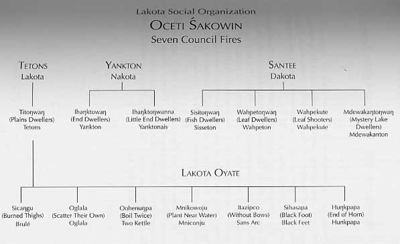- Profile
- Images
Location: [unknown]
Surnames/tags: native_americans Lakota Dakota
Contents |
Welcome to the Ojibwe Team
Native American Project Free Space Page

|
| The Dakota |
Introduction
This team focuses on tribes or Native peoples associated as Ojibwe, formerly referred to as "Sioux," that also include the Dakota, Lakota and Nakota.
See : Dakota People (Wikipedia)
From Lakota/Nakota/Dakota[1]
- The names the people we call Sioux have for themselves are the Lakota, Nakota or Dakota, meaning "friends . . . allies . . . to be friendly." At an earlier time, the Sioux evolved into three main groups speaking different dialects of the same language. The Dakota were the largest group and are considered to be the mother group. The Nakota were next in size, followed by the Lakota. Winter count records indicate that there was strife within the Sioux tribal family which may have been associated with a rise in power of the Lakota.
- The Dakota, who were also called the Santee Sioux, occupied a region east of the Mississippi in what is currently Minnesota. They were divided into four bands: the Mdewakantonwon, who are now in Minnesota, Flandreau, SD, and the Santee Reservation in Nebraska; the Wahpeton, who are now at the Devil's Lake Reservation, ND, Flandreau, SD, and Sisseton, SD; the Wahpekute, who are now at the Santee Reservation in Nebraska and Fort Peck, MT; and the Sisseton who are at Devil's Lake in ND and Sisseton, SD. Sisseton Wahpeton Community College has a History & Culture page on their site.
- The Nakota, also known as the Yanktonai or Yankton Sioux, split from the Dakota and moved to the prairies in the region that is now southeast South Dakota. They were divided into three bands: Yankton who are now on the Yankton Reservation in SD; the Upper Yanktonai who are split between the Standing Rock Reservation in SD and the Devil's Lake Reservation in ND; Lower Yanktonai who are split between the Crow Creek Reservation in SD and the Fort Peck Reservation in MT.
- The Lakota, sometimes known as the Teton Sioux, moved to a region west of the Missouri River. The Lakota became the largest of these groups, developing what is known as the Plains Indian Culture after receiving the horse in the seventeenth century. They are divided into seven bands: the Oglala now on the Pine Ridge Reservation in SD, Sicangu or Brulé who are now on the Rosebud and the Lower Brulé Reservation in SD, Hunkpapa who are now at the Standing Rock Reservation SD & ND, Miniconjous now at the Cheyenne River Reservation, SD, Sihasapa or Blackfoot now at Standing Rock or Cheyenne River, Itazipacola or Sans Arc now at Cheyenne River, and Oohenupa or Two Kettle also at Cheyenne River (later declared to be tribes by the U.S. government).
Of course there are tribal members who live off the reservation as well.
From Wikipedia:Sioux
- Sioux /ˈsuː/ are a Native American/American Indian and First Nations people in North America. The term can refer to any ethnic group within the Great Sioux Nation or any of the nation's many language dialects. The Sioux comprise three major divisions based on Siouan dialect and subculture: the Santee, the Yankton-Yanktonai, and the Lakota.
- The Santee (Isáŋyathi; "Knife"), also called Eastern Dakota, reside in the extreme east of the Dakotas, Minnesota and northern Iowa. The Yankton and Yanktonai (Iháŋktȟuŋwaŋ and Iháŋktȟuŋwaŋna; "Village-at-the-end" and "Little village-at-the-end"), collectively also referred to as the Western Dakota or by the endonym Wičhíyena, reside in the Minnesota River area. They are considered to be the middle Sioux, and have in the past been erroneously classified as Nakota. The Lakota, also called Teton (Thítȟuŋwaŋ; possibly "Dwellers on the prairie"), are the westernmost Sioux, known for their hunting and warrior culture.
- Today, the Sioux maintain many separate tribal governments scattered across several reservations, communities, and reserves in North Dakota, South Dakota, Nebraska, Minnesota, and Montana in the United States; and Manitoba and southern Saskatchewan in Canada.
- The name Sioux derives from the [Ojibwe] word “Nadowessioux” which means “Snake” or “Enemy.” Other definitions trace it too early Ottawa (Algonquian) singular /na:towe:ssi/ (plural /na:towe:ssiwak/) “Sioux,” apparently from a verb meaning “to speak a foreign language”, however, the Sioux generally call themselves Lakota [or Nakota] or Dakota[; Dakota] meaning “friends, allies, or to be friendly.”[2]
Template
If you do not know which of the above tribes to use (Lakota, Dakota, Nakota), please use:
- {{Native American|tribe=Ojibwe}}
We are moving away from the term "Sioux".
Categories
If you do not know which of the above tribes to use (Lakota, Dakota, Nakota), please use:
- [[Category:Ojibwe]]
Sample Profiles
Maps

|
| Lakota in the West, Nakota in the middle, and Dakota in the East |
Language
Miscellaneous
- Woodrow Wilson Keeble Of the Sisseton Wahpeton Oyate Tribe, Master Sergeant 2nd Battalion, 19th Infantry Regiment, 24th Infantry Division. Medal of Honor, Silver Star x 2, Bronze Star with V Device x 2, Wounded in Action x 5 Purple Hearts x 4.
Resources
- YouTube Video Oceti Sakowin: The People of the Seven Council Fires.
Sources
See also:
- Dakota (Includes Dakota, Nakota, Lakota) aka The Great Sioux Nation
- Login to edit this profile and add images.
- Private Messages: Send a private message to the Profile Manager. (Best when privacy is an issue.)
- Public Comments: Login to post. (Best for messages specifically directed to those editing this profile. Limit 20 per day.)
 Jillaine Smith
Jillaine Smith